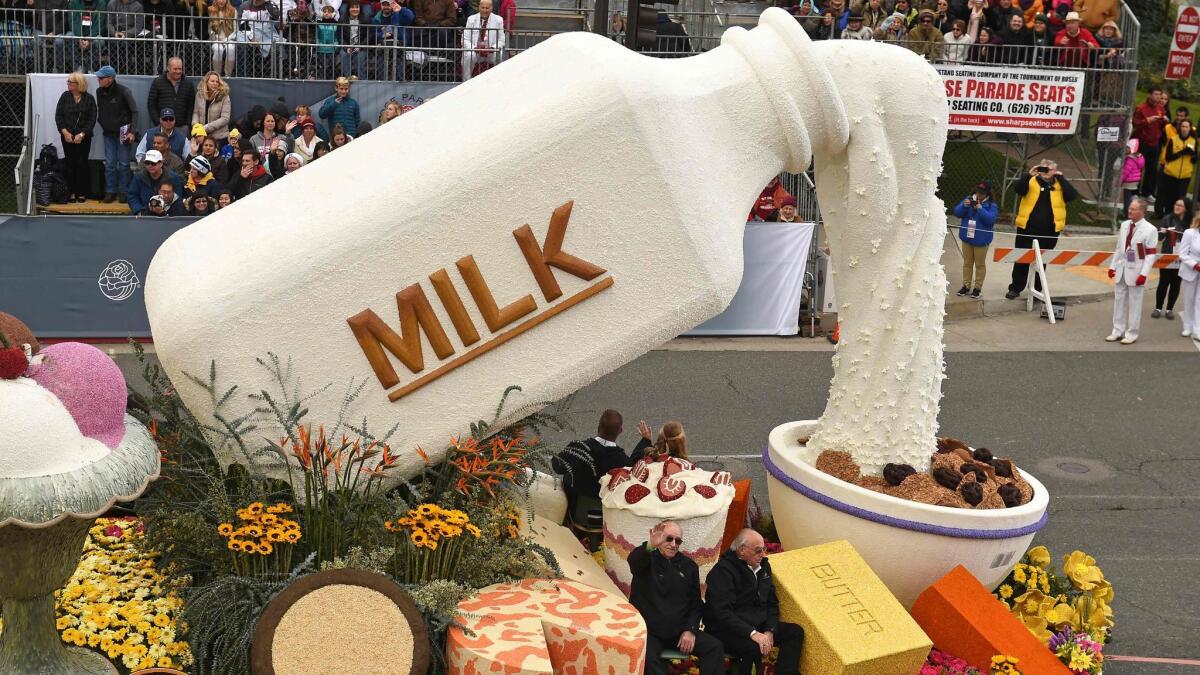Editorial: Got ‘milk’? Dairy farmers rage against imitators but consumers know what they want

Sales of plant-based milk alternatives have been skyrocketing in recent years. Of course, no marketer in her right mind would try to sell anything with such a clunky, unappetizing name. Instead, they are sold as cashew milk, almond milk, hazelnut milk and a handful of other “milks” from unlikely sources with names that evoke creamy wonderfulness.
It drives producers of what you might call “traditional” milk — that is, the people who sell the old-fashioned, nutritious white liquid that comes from cows — a little nuts that the purveyors of nondairy drinks are calling their product “milk” and directly competing with the real thing in refrigerated cases across America.
It was one thing when there was just soy milk. But now that there are all manner of “milk” products concocted from the oddest things — cashews, hemp, even quinoa, for heaven’s sake — the dairy industry has had enough. Last month, on its behalf, a bipartisan group of 32 members of Congress from agricultural states sent a letter to the Food and Drug Administration asking for a crackdown on the proliferation of faux lait.
This is no frothy matter to milk producers who have seen decades of decline in milk consumption. “These hard-working Americans have experienced deep cuts in income as milk prices have plunged 40 percent since 2014,” the members of Congress wrote in their letter. The authors include two California congressmen from the state’s agricultural heartland, Rep. David Valadao (R-Hanford) and Rep. Devin Nunes (R-Tulare).
Americans’ waning interest in drinking milk may be attributable, in part, to a better understanding of its provenance and production.
Federal regulations (21 CFR 131.110, to be exact) define milk as “the lacteal secretion, practically free from colostrum, obtained by the complete milking of one or more healthy cows.” And that means, according to the letter from the members of Congress, that it is illegal for milk imitators to profit from using milk’s good name.
But perhaps it is federal regulations that are out of touch with consumer trends. Though it is true that milk alternatives are generally less nutritious than the real thing, which is packed full of protein, calcium, and vitamins A and D, there’s no evidence that consumers have been tricked into buying a less nutritious plant-based alternative or that they’re unaware of the difference. Most people are smart enough to understand that quinoa milk isn’t cow’s milk flavored with quinoa (because, who would buy that?) just as as they can tell the difference between goat’s milk and Milk of Magnesia.
Indeed, Americans’ waning interest in drinking milk may be attributable, in part, to a better understanding of its provenance and production. These days, there are vegans eager to enjoy a bowl of cereal or ice cream without cow’s milk, often because they’re concerned about the treatment of the animals. There are parents concerned about the use of growth hormones in cows. There are people who, for whatever reason, don’t like the taste of cow’s milk and are pleased to have alternatives available.
So far, the FDA hasn’t responded to the letter. Even if the new leadership of the FDA were inclined to expend resources protecting the “milk” brand for the dairy lobby and were to force imitators to change their labels, it’s uncertain whether that would have any effect on consumption habits.
Nor is it clear if a crackdown would stop the word “milk” from being used in labeling. In 2011, the FDA sent a letter to CytoSport Inc. in Northern California warning it to stop mislabeling its popular Muscle Milk brand nutritional shakes because they don’t contain milk. (Happily, it doesn’t contain muscles, either.) Yet, Muscle Milk is still readily available for purchase in major retail stores.
Perhaps that’s because the word “milk” — like its close dairy relations “butter” and “cream” — is a relatively generic term that can’t be easily controlled through trademarks and copyrights.
It’s unfortunate that the dairy industry is blaming milk imitators — rather than a change in consumers’ tastes — for its woes. This is the industry, after all, that came up with one of the more memorable advertising campaigns in recent history: “Got Milk?”
In the end, consumers aren’t really dumb at all. Most of us know by now that there’s no cream in Cream of Wheat, no butter in cocoa butter and no grapes in Grapenuts. Or nuts, for that matter. And we know what milk is, too.
Follow the Opinion section on Twitter @latimesopinion and Facebook
More to Read
A cure for the common opinion
Get thought-provoking perspectives with our weekly newsletter.
You may occasionally receive promotional content from the Los Angeles Times.










